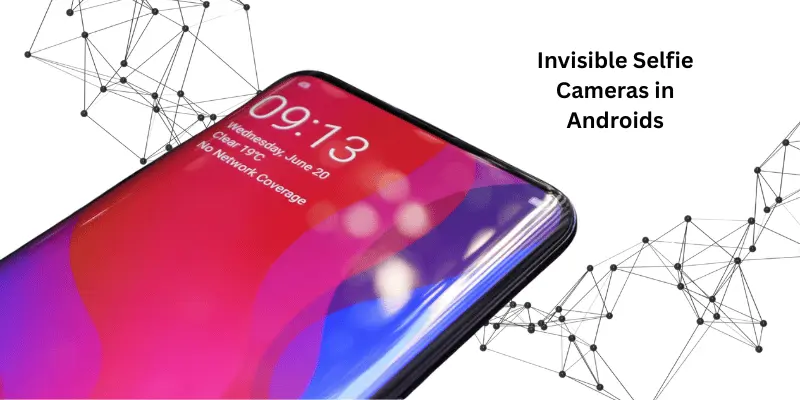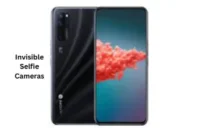Invisible Selfie Cameras Coming Soon to Chinese Smartphones
Published: July 27, 2025
Hey selfie lovers, here is some big news for you! Invisible Selfie Cameras Coming Soon to Chinese Smartphones. Yes, you can explore new features.
Imagine looking at your phone screen and seeing no camera at all—but it still takes a perfect selfie. Sounds like science fiction? Not anymore!
These are invisible front-facing cameras that sit behind the phone’s screen, completely hidden when not in use.
That means no black circles, notches, or cutouts on your screen. Just a clean, full-screen experience from top to bottom.
This technology is part of a larger trend where phone makers aim to provide users with sleeker, more immersive displays.
If you’ve ever been bothered by that little black dot on your screen while watching a movie or playing a game, this update is going to feel like a dream.
What’s So Cool About Invisible Selfie Camera

This new feature isn’t just about looks—it’s also about better everyday experiences.
Imagine scrolling TikTok, watching Netflix, or video calling your friends, all on a display that feels like one smooth sheet of glass. No more tiny black circles ruining your view.
The under-display camera stays hidden until you need it. When you open your selfie camera, it activates from behind the screen.
The software and camera sensor work together to adjust lighting and clarity, so your selfies still look natural, even though the camera is hidden.
This also helps brands create more futuristic designs that feel like they’re from the next generation. It’s a big win for people who care about both aesthetics and innovation.
Smarter Face Unlock: Now Even Safer
Along with the invisible camera, phone companies are testing 3D face unlock features that use infrared depth sensors to scan your face.
Unlike simple face unlock that looks at a photo, 3D face recognition creates a real map of your facial structure, making it much harder to fool.
Here’s the amazing part: this entire system, including the sensors, can now be placed under the screen, too.
That means no visible camera module or extra sensor area. Just pure screen—and top-notch security.
If successful, this would make Android phones as secure as iPhones that use Apple’s Face ID, but with a cleaner, more modern design.
It’s especially useful for unlocking your phone in the dark, authenticating apps, or even making payments.
Why Is This a Big Deal?
Most Android phones today force users to pick between two things:
A clean, full display with an under-display camera but no real face recognition, or A visible 3D face unlock system that requires extra space on the front of the phone.
For example, the ZTE nubia Z70S Ultra hides the camera but lacks advanced face security.
Meanwhile, the Honor Magic 7 Pro features 3D face unlock, but it is clearly visible through the camera module.
Now, brands like Vivo, Xiaomi, Oppo, Huawei, and ZTE are racing to combine both features into one phone.
The idea is simple: secure unlocking and invisible camera design, working together in harmony.
This would make Android phones not only more secure but also much more modern-looking and truly competitive with Apple in both design and tech.
What’s the Catch?
Of course, this kind of futuristic tech doesn’t come without a few growing pains.
- Camera quality: Since light must pass through the screen to reach the camera, image clarity and brightness are slightly reduced. Your selfies may appear softer or somewhat hazy, especially in low-light conditions.
- Face detection accuracy: Placing 3D sensors under the screen is tricky. The display layer can interfere with how light bounces off your face, potentially reducing the accuracy of the scan.
- Software optimization: Brands are working hard to develop more intelligent AI and camera software that can automatically adjust exposure, lighting, and sharpness to compensate for any loss in camera quality.
But don’t worry—tech companies are investing heavily in solving these issues. With each test, the cameras are getting better, faster, and more reliable.
When Can You Buy One?
So far, the ZTE nubia Z70S Ultra has already shown what an under-display selfie camera can look like.
The Honor Magic 7 Pro has shown us secure 3D face unlocking. But no phone yet combines both in one single, clean design.
That’s what’s about to change.
According to industry insiders and tech tipsters like Digital Chat Station, these features are now in final testing stages.
If all goes well, we could see the first smartphones with both invisible selfie cameras and 3D face unlock as early as 2025 or early 2026.
And the first ones to launch it? Most likely, Chinese smartphone brands.
Why Should You Care?
Let’s be real: most of us want our phones to look cool and work fast. This upcoming tech checks both boxes.
Want a cleaner screen for videos and games? ✅
Hate ugly notches or punch-hole cameras? ✅
Want to unlock your phone securely in a split second? ✅
Want your phone to feel futuristic and smart? ✅
This technology is designed for real people like you, who care about both form and function.
When Can You Buy One?
So far, the ZTE nubia Z70S Ultra has already shown what an under-display selfie camera can look like.
The Honor Magic 7 Pro has shown us secure 3D face unlocking. But no phone yet combines both in one single, clean design.
That’s what’s about to change.
According to industry insiders and tech tipsters like Digital Chat Station, these features are now in final testing stages.
If everything goes smoothly, we could see the first smartphones with both invisible selfie cameras and 3D face unlock as early as late 2025 or early 2026.
And the first to launch it? Most likely, leading Chinese smartphone brands like Vivo, Xiaomi, Oppo, Huawei, or ZTE.
Final Thoughts
The smartphone world is evolving fast, and it’s about to get even more exciting.
With invisible selfie cameras, notch-free screens, and bright face unlock, your phone won’t just be smarter—it’ll look and feel like something from the future.
The best part? You won’t have to wait too long.
So if you’re thinking of upgrading your phone, you might want to hold out a bit longer—because what’s coming next is beautiful, secure, and almost invisible.
FAQs
An under-display selfie camera is a front camera that sits beneath the phone’s screen, making it invisible when not in use. When you open the camera app, the display above it becomes semi-transparent, allowing light to reach the camera sensor. Advanced software then adjusts the lighting and clarity to capture usable images. This creates a full-screen experience without notches or punch-holes.
Not yet. Since light has to pass through the display, images from under-display cameras can be slightly less sharp or bright, especially in low light. However, phone makers are using AI and image processing to improve quality. With each new version, the results are getting closer to traditional front cameras.
Yes, but it’s still being developed. 3D face unlock requires depth sensors that scan your face in three dimensions, which is harder to do under a screen. Some brands are testing ways to place these sensors under the display without affecting accuracy. If successful, this will offer Face ID-level security with a completely clean screen.
Brands like Vivo, Xiaomi, Oppo, Huawei, and ZTE are leading the way. ZTE already released phones with under-display cameras, while Honor and Xiaomi have showcased 3D face recognition. Now, the race is on to combine both features in one device. Early leaks suggest this could happen by 2025 or early 2026.
The main challenge is that the display can interfere with camera clarity and face-scanning accuracy. This can result in slightly blurry selfies and less reliable face unlock. Also, software needs to work extra hard to correct lighting and sharpness. But with ongoing development, these issues are steadily being resolved.

- Be Respectful
- Stay Relevant
- Stay Positive
- True Feedback
- Encourage Discussion
- Avoid Spamming
- No Fake News
- Don't Copy-Paste
- No Personal Attacks



- Be Respectful
- Stay Relevant
- Stay Positive
- True Feedback
- Encourage Discussion
- Avoid Spamming
- No Fake News
- Don't Copy-Paste
- No Personal Attacks





